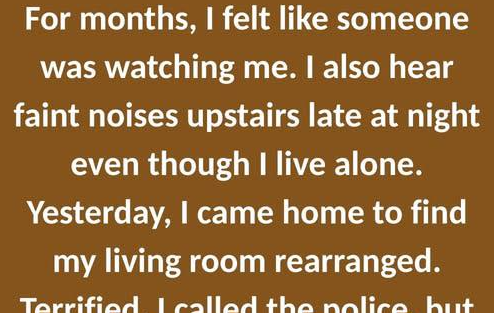For months, I sensed a subtle presence within my home — calm and reassuring, always present in the background. At times, I caught soft noises drifting from upstairs during the evening hours, despite residing there by myself. I dismissed those moments as products of an active mind, yet the sensation persisted gently. One sunny afternoon, I came back to discover my living room transformed in subtle ways. Puzzled and a bit uneasy, I reached out to the local authorities right away for assistance. The officers examined every nook and cranny thoroughly and reported no signs of anything out of place. As they gathered their things to depart, one officer stopped for a moment and inquired in a warm tone, “Have you experienced any added pressure or moments of isolation recently?” His expression conveyed empathy and understanding, free from any skepticism. That inquiry surprised me deeply; I had not paused long enough to consider my own state. My days overflowed with transitions, periods of quiet reflection, and routines that flowed seamlessly into one another without much distinction.
After the officers headed out, I took another careful look around the space. My cherished armchair had been positioned to face the large window, allowing streams of sunlight to pour in during the early hours. A long-neglected pastime — my collection of knitting supplies — rested openly on the side table, seemingly ready for me to pick up the needles once more. In that instant, clarity washed over me: these changes represented gentle prompts rather than any form of unwelcome entry, highlighting aspects of my routine I had gradually overlooked. My surroundings had grown peaceful and serene, not filled with danger — merely patient, awaiting my active participation once again. A wave of appreciation replaced any lingering worry. I picked up the phone to connect with my sister, followed by a dear companion from years past, and arranged gatherings filled with laughter and shared stories. I drew back the drapes fully, dove back into my knitting projects, and let melodies from my favorite playlists echo through the rooms once more.
Life often sends us subtle signals in surprising forms to help us realign with our inner selves. During that serene interlude, insight dawned clearly — no external eyes observed me. Instead, a kind reminder encouraged me to embrace living fully.
Embracing the Subtle Signs Around Us
That experience opened my eyes to how everyday environments can communicate in quiet, meaningful ways. Homes serve as more than shelters; they reflect our habits, emotions, and unspoken needs. In my case, the rearranged furniture and opened basket acted as invitations to revisit passions that brought fulfillment. Knitting, for instance, had always been a source of relaxation for me. The rhythmic motion of yarn looping around needles created a meditative flow, easing the mind after long days. Rediscovering it felt like reuniting with an old ally, one that patiently waited on the shelf.
Consider the armchair by the window. Positioning it there transformed a simple seat into a vantage point for observing the world outside. Mornings became opportunities to sip coffee while watching birds flit among the branches or neighbors stroll by with their dogs. Natural light flooded the area, brightening not only the room but also my outlook. Sunlight carries proven benefits, boosting mood through vitamin D production and regulating sleep cycles. Incorporating such elements into daily routines fosters a sense of vitality and connection to the broader rhythm of nature.
Reaching out to my sister marked another pivotal step. Our conversations flowed easily, covering everything from childhood memories to current aspirations. She shared updates about her garden, describing vibrant blooms and the satisfaction of nurturing plants from seeds. Those exchanges reminded me of the value in family bonds, how they provide anchors during times of change. Similarly, reconnecting with my old friend brought back tales of shared adventures — hikes through forested trails, late-night discussions over homemade meals. Planning future meetups infused my calendar with anticipation, turning solitary evenings into prospects for warmth and engagement.
The Power of Small Habits in Daily Living
Filling the home with music added another layer of richness. Selecting playlists became a deliberate act, choosing tracks that evoked positive emotions. Classical pieces by composers like Beethoven offered grandeur and inspiration, while folk tunes from artists such as Joni Mitchell brought nostalgia and comfort. Sound waves filled the air, creating an atmosphere alive with energy. Music influences brain chemistry, releasing dopamine and enhancing overall well-being. It turned mundane tasks, like preparing dinner or folding laundry, into enjoyable rituals.
Beyond these actions, I explored additional ways to infuse the space with personal touches. Adding potted plants to shelves introduced greenery, improving air quality and adding visual appeal. Herbs like basil and mint on the windowsill provided fresh scents and ingredients for cooking. Arranging books on the coffee table — favorites ranging from novels by Jane Austen to non-fiction on mindfulness — encouraged spontaneous reading sessions. These elements wove together to form a tapestry of intentional living, where every corner reflected care and purpose.
Reflecting on the officers’ visit, their thorough search reassured me of the home’s security. Yet, the kind officer’s question lingered, prompting deeper self-examination. Stress from recent life shifts had accumulated subtly, manifesting in overlooked details. Solitude, while sometimes welcome, had extended longer than intended, leading to a quieter existence. Acknowledging this allowed for proactive changes, transforming potential isolation into chosen serenity.
Building Connections and Community
Inviting company over became a regular occurrence. My sister arrived one weekend with ingredients for a collaborative baking session. We kneaded dough for fresh bread, the aroma filling the kitchen and sparking stories from our youth. Laughter echoed as flour dusted the counters, creating memories in the moment. My old friend joined soon after for an evening of board games and tea. Strategic moves and friendly banter bridged any gaps time had created, strengthening our tie.
These gatherings extended beyond immediate circles. I joined a local knitting group, meeting weekly at a cozy community center. Participants shared patterns, tips, and personal anecdotes, fostering a sense of belonging. Hands busied with yarn while conversations delved into topics like travel dreams or favorite recipes. Such groups highlight the benefits of shared interests, offering support networks and new friendships.
Outdoor activities complemented indoor rejuvenation. Morning walks through nearby parks allowed immersion in fresh air and changing seasons. Leaves rustling underfoot, the scent of damp earth after rain — these sensory experiences grounded me in the present. Observing community events, like farmers’ markets or art fairs, inspired further engagement. Purchasing handmade crafts or fresh produce supported local artisans and added unique items to my home.
Nurturing Personal Growth Through Reflection
Journaling emerged as a valuable practice. Each evening, I noted three moments of gratitude, no matter how small. Entries included the warmth of sunlight on the armchair, the satisfaction of completing a knitting row, or the joy in a phone call. This habit cultivated mindfulness, shifting focus toward abundance rather than absence. Over time, patterns revealed themselves — recurring themes of creativity, connection, and nature.
Reading materials on personal development provided further insights. Books exploring habits, such as those by James Clear, emphasized the impact of incremental changes. Implementing suggestions, like stacking new routines onto existing ones, made transitions smoother. For example, playing music while knitting combined relaxation with productivity.
Exploring creative outlets expanded horizons. Beyond knitting, I experimented with watercolor painting. Supplies gathered dust in a drawer, but reviving them brought bursts of color to paper. Abstract designs captured emotions, serving as visual diaries. Sharing pieces with friends elicited encouragement, reinforcing the cycle of expression and feedback.
The Broader Lessons in Everyday Wonders
This journey underscored how environments mirror inner states. Subtle shifts, like rearranged items, can signal readiness for renewal. Embracing them leads to enriched experiences, where homes evolve into sanctuaries of growth. Connections with others amplify this, creating ripples of positivity.
In wider terms, many encounter similar nudges. Busy schedules sideline hobbies, leaving spaces echoing emptiness. Recognizing these cues invites reclamation of joy. Simple acts — opening curtains, playing melodies, reaching out — weave fulfillment into the fabric of days.
Ultimately, that initial sense of presence revealed itself as an internal compass, guiding toward vibrancy. No mysteries lurked; only opportunities awaited. Living fully involves noticing, acting, and savoring the process.






